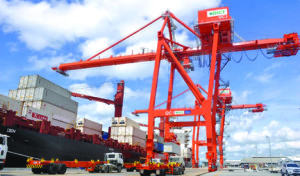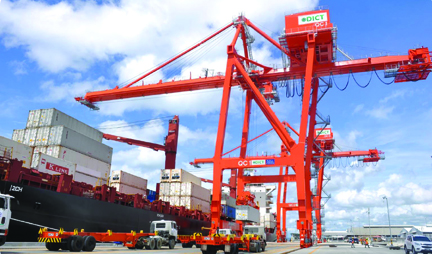
DAVAO International Container Terminal (DICT) in southern Philippines expects to handle almost 58% or 200,000 twenty-foot equivalent units (TEU) of its annual capacity of 345,000 TEUs by 2014.
The container terminal in Panabo City, Davao del Norte was established by San Vicente Terminal & Brokerage Services Inc. (SVTBSI), a member of the ANFLOCOR Group of Companies, in partnership with two of the country’s top exporters of Cavendish bananas — Tagum Agricultural Development Co. Inc. (Tadeco) and Dole-Stanfilco.
Located at the crossroads where major agricultural plantations are situated, the port handles mainly reefer export shipments of fresh bananas and pineapples.
SVTBSI assistant general manager Bonifacio Licayan admitted that low volume is expected for 2013, being the startup year for DICT. “We are still introducing the port to all potential users,” Licayan told PortCalls, replying to an emailed questionnaire.
But he expressed optimism that the banana and pineapple industry will continue to grow and, as a gateway, DICT will “unlock the potential of the region to industries other than agriculture”, in the process opening up more investment opportunities in the logistics industry.
The port is expected to serve the import needs of Southern Mindanao industries such as paper, plastic pellet, fertilizer and chemicals.
“We also envision the port to be a catalyst for industries to locate nearby, thus creating a new market for imports,” Licayan added.
Major exporters are already using the facility, called on by “a number of vessels from various shipping lines”, including from Pacific International Lines, Licayan said. Discussions with other carriers are ongoing.
Port rates are similar to those at Sasa Wharf, the more established port in Davao, before the 10% provisional increase effected in June this year by the Philippine Ports Authority. Cranage charges have, however, been added to stevedoring services. The charge is similar to Mindanao Container Terminal’s rate.
Construction of the P2.7-billion DICT began on June 10, 2012 and was completed on August 12 this year. The port handled its first vessel in May and is on a test run to ensure all systems and equipment are working perfectly, Licayan said. No official opening date has yet been set.
The container yard sits on 8.8 hectares and can house 2,620 forty-foot equivalent units – 1,620 laden and 1,000 empties — at any given time.
Covering 1.6 hectares, the berth is 250 meters long and 33 meters wide with a competitive average depth at fender line of 15 meters.
Licayan took pride in DICT being the only port in the region that uses the terminal operating system Navis Sparcs N4.
The port is equipped with two Panamax-size quay cranes; three Mitsui rubber-tired gantry cranes; three empty container handlers; one Linde reachstacker; and 10 Terberg terminal tractors with bomb carts, or shuttle chassis designed for moving and repositioning dry cargo in terminals.
Capable of providing 100% of the facility’s power requirements, including for 720 reefer plugs, are seven megavolt ampere standby generating sets.
Within the premises are new three-storey buildings housing offices of the Bureau of Customs and other port-related government agencies, as well as office spaces for port users such as shipping lines, shippers, customs brokers.
Asked about reports the port has a turnaround of 24 hours, Licayan said this is plain talk. “We are able to turn around vessels in seven to eight hours compared with what normally takes about 2 to 3 days in a nearby port. We are achieving an overall average of 23 moves per crane per hour.”
He added, “Exporters and importers will benefit from this efficient movement of their cargo.” ––Roumina M. Pablo





